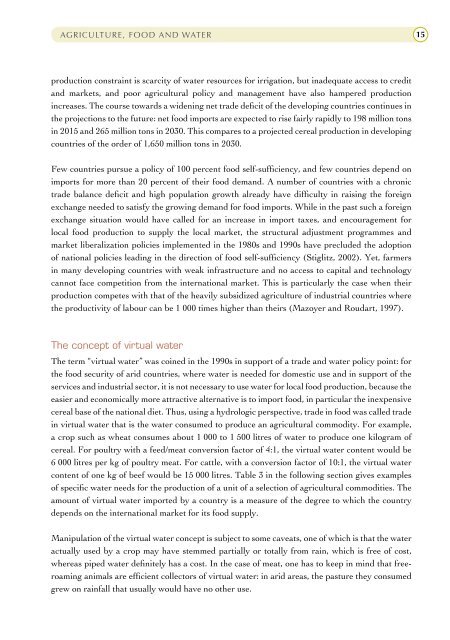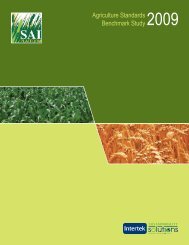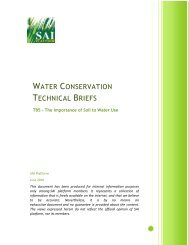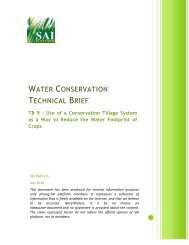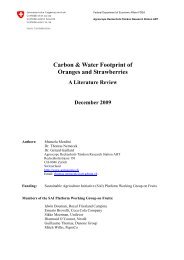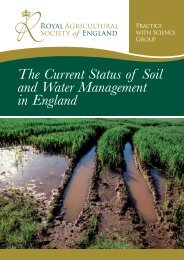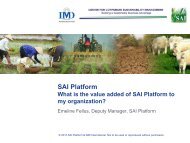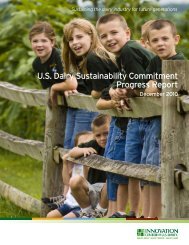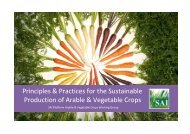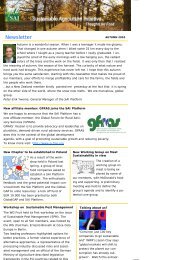Agriculture, food and water - FAO.org
Agriculture, food and water - FAO.org
Agriculture, food and water - FAO.org
You also want an ePaper? Increase the reach of your titles
YUMPU automatically turns print PDFs into web optimized ePapers that Google loves.
AGRICULTURE, FOOD AND WATER<br />
15<br />
production constraint is scarcity of <strong>water</strong> resources for irrigation, but inadequate access to credit<br />
<strong>and</strong> markets, <strong>and</strong> poor agricultural policy <strong>and</strong> management have also hampered production<br />
increases. The course towards a widening net trade deficit of the developing countries continues in<br />
the projections to the future: net <strong>food</strong> imports are expected to rise fairly rapidly to 198 million tons<br />
in 2015 <strong>and</strong> 265 million tons in 2030. This compares to a projected cereal production in developing<br />
countries of the order of 1,650 million tons in 2030.<br />
Few countries pursue a policy of 100 percent <strong>food</strong> self-sufficiency, <strong>and</strong> few countries depend on<br />
imports for more than 20 percent of their <strong>food</strong> dem<strong>and</strong>. A number of countries with a chronic<br />
trade balance deficit <strong>and</strong> high population growth already have difficulty in raising the foreign<br />
exchange needed to satisfy the growing dem<strong>and</strong> for <strong>food</strong> imports. While in the past such a foreign<br />
exchange situation would have called for an increase in import taxes, <strong>and</strong> encouragement for<br />
local <strong>food</strong> production to supply the local market, the structural adjustment programmes <strong>and</strong><br />
market liberalization policies implemented in the 1980s <strong>and</strong> 1990s have precluded the adoption<br />
of national policies leading in the direction of <strong>food</strong> self-sufficiency (Stiglitz, 2002). Yet, farmers<br />
in many developing countries with weak infrastructure <strong>and</strong> no access to capital <strong>and</strong> technology<br />
cannot face competition from the international market. This is particularly the case when their<br />
production competes with that of the heavily subsidized agriculture of industrial countries where<br />
the productivity of labour can be 1 000 times higher than theirs (Mazoyer <strong>and</strong> Roudart, 1997).<br />
The concept of virtual <strong>water</strong><br />
The term “virtual <strong>water</strong>” was coined in the 1990s in support of a trade <strong>and</strong> <strong>water</strong> policy point: for<br />
the <strong>food</strong> security of arid countries, where <strong>water</strong> is needed for domestic use <strong>and</strong> in support of the<br />
services <strong>and</strong> industrial sector, it is not necessary to use <strong>water</strong> for local <strong>food</strong> production, because the<br />
easier <strong>and</strong> economically more attractive alternative is to import <strong>food</strong>, in particular the inexpensive<br />
cereal base of the national diet. Thus, using a hydrologic perspective, trade in <strong>food</strong> was called trade<br />
in virtual <strong>water</strong> that is the <strong>water</strong> consumed to produce an agricultural commodity. For example,<br />
a crop such as wheat consumes about 1 000 to 1 500 litres of <strong>water</strong> to produce one kilogram of<br />
cereal. For poultry with a feed/meat conversion factor of 4:1, the virtual <strong>water</strong> content would be<br />
6 000 litres per kg of poultry meat. For cattle, with a conversion factor of 10:1, the virtual <strong>water</strong><br />
content of one kg of beef would be 15 000 litres. Table 3 in the following section gives examples<br />
of specific <strong>water</strong> needs for the production of a unit of a selection of agricultural commodities. The<br />
amount of virtual <strong>water</strong> imported by a country is a measure of the degree to which the country<br />
depends on the international market for its <strong>food</strong> supply.<br />
Manipulation of the virtual <strong>water</strong> concept is subject to some caveats, one of which is that the <strong>water</strong><br />
actually used by a crop may have stemmed partially or totally from rain, which is free of cost,<br />
whereas piped <strong>water</strong> definitely has a cost. In the case of meat, one has to keep in mind that freeroaming<br />
animals are efficient collectors of virtual <strong>water</strong>: in arid areas, the pasture they consumed<br />
grew on rainfall that usually would have no other use.


